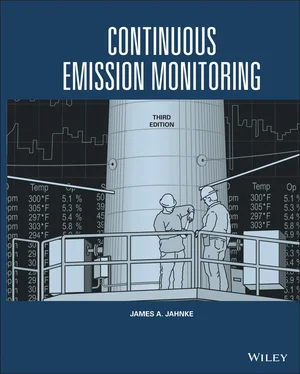James A. Jahnke - Continuous Emission Monitoring
Здесь есть возможность читать онлайн «James A. Jahnke - Continuous Emission Monitoring» — ознакомительный отрывок электронной книги совершенно бесплатно, а после прочтения отрывка купить полную версию. В некоторых случаях можно слушать аудио, скачать через торрент в формате fb2 и присутствует краткое содержание. Жанр: unrecognised, на английском языке. Описание произведения, (предисловие) а так же отзывы посетителей доступны на портале библиотеки ЛибКат.
- Название:Continuous Emission Monitoring
- Автор:
- Жанр:
- Год:неизвестен
- ISBN:нет данных
- Рейтинг книги:4 / 5. Голосов: 1
-
Избранное:Добавить в избранное
- Отзывы:
-
Ваша оценка:
- 80
- 1
- 2
- 3
- 4
- 5
Continuous Emission Monitoring: краткое содержание, описание и аннотация
Предлагаем к чтению аннотацию, описание, краткое содержание или предисловие (зависит от того, что написал сам автор книги «Continuous Emission Monitoring»). Если вы не нашли необходимую информацию о книге — напишите в комментариях, мы постараемся отыскать её.
The new edition of the only single-volume reference on both the regulatory and technical aspects of U.S. and international continuous emission monitoring (CEM) systems Continuous Emission Monitoring
Continuous Emission Monitoring:
Continuous Emission Monitoring, Third Edition
Continuous Emission Monitoring — читать онлайн ознакомительный отрывок
Ниже представлен текст книги, разбитый по страницам. Система сохранения места последней прочитанной страницы, позволяет с удобством читать онлайн бесплатно книгу «Continuous Emission Monitoring», без необходимости каждый раз заново искать на чём Вы остановились. Поставьте закладку, и сможете в любой момент перейти на страницу, на которой закончили чтение.
Интервал:
Закладка:
(2‐3) 
where
CO2 = annual CO2 mass emissions (metric tons) for a particular type of fuel
Fuel = quantity of fuel combusted during the year (tons, scf, gal)
HHVd = default (Tier 1) or measured (Tier 2) high heating value of fuel (mmBtu per quantity of fuel)
EF = fuel‐specific default CO2 emission factor (kg CO2/mmBtu)
Tier 3 applies to sources larger than 250 mmBtu that have not been required to install a CEM system. In this tier, sources are required to monitor fuel use and the carbon content of the fuel instead of the fuel’s high heating value. CEM systems are used for Tier 4 reporting, where annual emissions are calculated as a pollutant mass rate times operating time. Methane and nitrous oxide emissions are reported using default emission factors for CH 4and N 2O in Equation 2‐3. The CH 4and N 2O calculate emissions data are combined with the CO 2data to report greenhouse gas emissions as CO 2e, carbon dioxide equivalents.
Greenhouse gas issues and reporting procedures are discussed in greater detail in Chapter 14.
Office of Solid Waste CEM Requirements (40 CFR 266)
Through the authority of the Resource Conservation and Recovery Act (RCRA), the EPA Office of Solid Waste requires CEM systems to be installed for incinerators designed to burn hazardous waste and for boilers and industrial furnaces (“BIF” sources) that burn hazardous wastes as supplemental fuel under 40 CFR 266 (U.S. EPA 2020i). This program under RCRA is delegated for management by the states. For hazardous waste incinerators, initial trial burns of hazardous pollutants are used to set operating criteria for the facilities. In many permits, the CEM system is tied into the operating system, where feed is cut off if CO or THC levels exceed the established trigger levels, or if the O 2concentration decreases below the established limits. This is done, in part, to address the public's concern regarding emissions from such facilities.
BIF continuous emission monitoring requirements are found for CO in 40 CFR 266 §266.104(b)(2) and hydrocarbons (HC) in [§266.104(c)((3)]. In the BIF rules, performance specification for CO analyzers are given in Part 266 Appendix IX §2.1 and for hydrocarbon analyzers in §2.2. The performance specifications for CO are similar to those given in 40 CFR 60 Appendix BPerformance Specification 4a. A relative accuracy test is not required for Part 266 hydrocarbon analyzers.
Quality assurance requirements for Part 266 CO and HC monitoring systems are found in Appendix IX of Part 266, where daily calibration checks, daily system audits, quarterly calibration error (linearity) tests, and an annual performance specification tests are required. Conducting an annual performance specification test for the CO monitoring system implies that a seven‐day calibration drift test, in addition to a response time test and a RATA, would be required, in contrast to Part 60 Appendix F where only an annual RATA is required (U.S. EPA 2020e).
Monitoring requirements have also been promulgated for hazardous waste combustors under the MACT standards of 50 CFR 63 Subpart EEE. Section 63.1209(a) (ii) requires that either a CO or hydrocarbon analyzer be installed, along with an oxygen monitor, to report emissions corrected to 7% O 2. Cement kilns burning hazardous waste are also required to install a continuous opacity monitoring system (COMS).
Sewage Sludge Incineration (40 CFR 503)
EPA regulations concerning sludge management programs are found under Title 40 Subchapter O – Sewage Sludge and Part 501: State Sludge Management Program Regulations. Regulatory authority is given under the Clean Water Act, which requires that states must develop sludge management programs. Part 501 specifies the requirements that a State program must meet for it to be approved by EPA. Sewage sludge can be disposed of in a solid waste landfill, applied to the land, or incinerated. For landfill or land applications, limits for metal concentrations, loading levels, and pathogen density are specified.
Monitoring requirements for incineration of sewage sludge are given in Subpart E of 40 CFR 503 – Standards for the Use or Disposal of Sewage Sludge If the sludge is incinerated, the concern shifts from releases to the soil and groundwater to the efficiency of combustion and releases to the air. Total hydrocarbons are required to be monitored as specified in §503.45(a)(1) of the Code. In addition, the carbon monoxide concentration must be monitored as an indicator of combustion efficiency, where a limit of 100 ppm corrected to 7% O 2and zero percent moisture is specified. Total hydrocarbon concentration is similarly limited to 100 ppm corrected to 7% O 2and zero percent moisture. Accordingly, an oxygen concentration monitor and an instrument used to determine the moisture content must also be installed to monitor the stack exit gas continuously along with the THC and CO analyzers. No other requirements are given for the monitoring system and analyzers, other than that a calibration and maintenance logbook shall be retained [40 CFR 503.47(n)]. Design and operational requirements are specified for the total hydrocarbon analyzer, where it must use a flame ionization detector (FID), be calibrated with propane, and have a heated sampling line maintained at a temperature of 150 °C.
New sewage sludge incinerators are also regulated under New Source Performance Standard Subpart O if the incinerator was constructed after 11 June 1973. The regulation requires the installation of an oxygen analyzer only. Here, the instrument specifications require a ±5% relative accuracy as certified by the manufacturer and a calibration every 24 hours according to manufacturer procedures. No reference is made to the Part 60 Appendix Bor Appendix F CEM requirements, which are more complete.
State Programs and Federal Programs Administered by the States
State environmental control agencies are tasked with federal requirements to meet ambient air standards for SO 2, NO x, ozone, and particulate matter as PM 2.5. The states receive federal funding for this purpose and institute programs to monitor ambient air concentrations of these ambient pollutants. Ambient air monitoring shelters housing analyzers that use many of the same analytical techniques as CEM systems are located across the country, providing a continuous assessment of ambient air quality.
A number of regulatory mechanisms can be used by the states to require the installation of CEM systems as a tool in meeting their goals. Because of the differences in state agency regulatory policies and work‐force capabilities and limitations, CEM programs vary greatly between the states. Several states have very stringent programs, based on CEM compliance monitoring for enforcement and public assurances. Other states, which have less stringent programs, accept EPA NSPS delegation for regulating new sources and have adopted minimum requirements for existing sources. Different types of programs delegated or otherwise employed by the states, where CEM system installations may be required, are listed in Table 2‐2.
By applying established regulatory procedures, CEM systems can also be required to be installed on other source categories or used directly for compliance. The development of such regulations typically proceeds through public hearings, combined with many approval processes. Under these procedures, it can often take several years before a regulation is issued.
State Implementation Plan Requirements (40 CFR 5l)
Each state is required by the U.S. Clean Air Act to have a State Implementation Plan, or SIP, that will lead to the improvement and maintenance of the air quality such that all areas of the state will meet national ambient air quality standards. Federal requirements for SIPs are given in 40 CFR 51 – Requirements for Preparation, Adoption, and Submittal of Implementation Plans and 40 CFR 52 – Approval and Promulgation of Implementation Plans (U.S. EPA 2020b).
Читать дальшеИнтервал:
Закладка:
Похожие книги на «Continuous Emission Monitoring»
Представляем Вашему вниманию похожие книги на «Continuous Emission Monitoring» списком для выбора. Мы отобрали схожую по названию и смыслу литературу в надежде предоставить читателям больше вариантов отыскать новые, интересные, ещё непрочитанные произведения.
Обсуждение, отзывы о книге «Continuous Emission Monitoring» и просто собственные мнения читателей. Оставьте ваши комментарии, напишите, что Вы думаете о произведении, его смысле или главных героях. Укажите что конкретно понравилось, а что нет, и почему Вы так считаете.












